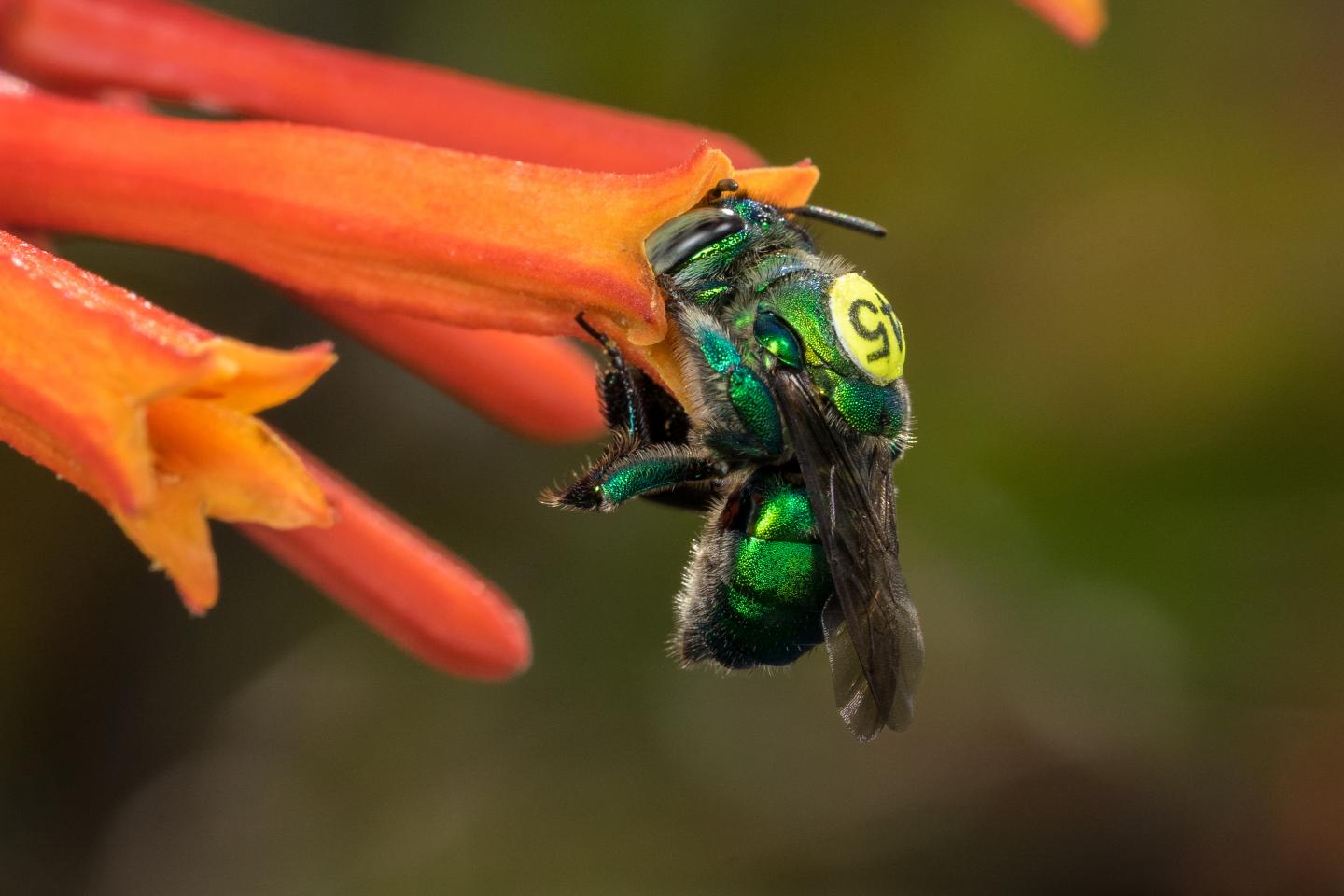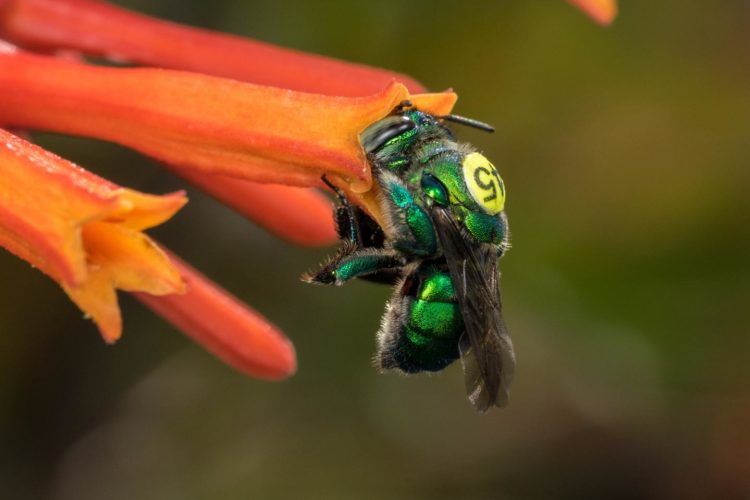
Credit: Thomas Eltz/Ruhr University Bochum
A male orchid bee zips around the rainforest, a flash of iridescent green against an equally emerald background. The bee stops at various flowers, fungi and dead trees, collecting fragrant particles and storing them in pockets in its hind legs. Then, it perches on a tree trunk. But the bee doesn’t rest. Instead, it flitters about, using its wings to disperse a bouquet of perfumes into the air.
The aromatic efforts are all for the sake of attracting a mate.
“We know that many animals produce pheromones and they usually produce them through some metabolic pathway,” said Associate Professor Santiago Ramirez, UC Davis Department of Evolution and Ecology. “But orchid bees are unique in that the majority of their pheromones are actually collected from plants and other sources like fungi.”
Orchid bees are master perfumers, and research suggests that the perfumes males concoct are unique to their specific species. For years, Ramirez, a member of the UC Davis Center for Population Biology, and recent Ph.D. graduate student Philipp Brand, Population Biology Graduate Group, have studied orchid bee mating behaviors, unraveling the complex chemicals responsible for successful procreation. The research has given them an unprecedented view into the formation of new species. And the driver of divergence: environmental perfumes.
In a study appearing in Nature Communications, Brand, Ramirez and their colleagues link the evolution of sexual signaling in orchid bees to a gene that’s been shaped by each species’ perfume preferences.
“Our study supports the hypothesis that in the orchid bee perfume communication system, the male perfume chemistry and the female preference for the perfume chemistry can simultaneously evolve via changes in a single receptor gene,” said Brand, whose thesis was the basis for the study.
“Imagine you have an ancestral species that uses certain compounds to communicate with each other,” said Ramirez. “If you have a chemical communication channel and then that chemical communication channel splits into two separate channels, then you have the opportunity for the formation of two separate species.”
A fragrant, front row seat to evolution
Of the 250 orchid bee species, Brand’s and Ramirez’s research focused on Euglossa viridissima and Euglossa dilemma, two separate species previously classified under a single scientific name. They diverged roughly 150,000 years ago. Physically and genetically, these two species are almost indistinguishable, but luckily, they primarily live in non-overlapping ranges in Central America and South America, with some overlap in Mexico’s Yucatán Peninsula.
“This is a neat distribution for the study of species formation because it reveals that the variation we observed is not just the product of geographic variation, and when the two species coexist, they still remain as separate species, even though they experienced hybridization in the recent past,” said Ramirez. “Each species is occupying a unique niche in chemical space.”
E. viridissima and E. dilemma are actually easier to tell apart by the chemical differences of their perfumes. Using gas chromatography and mass spectrometry, the researchers separated and analyzed each chemical compound in a male orchid bee’s enticing perfume. Between the perfumes of E. viridissima and E. dilemma, the difference came down to two molecules. E. viridissima‘s perfume contains a molecule called 2-hydroxy-6-nona-1,3-dienylbenzaldehyde (HNDB), and E. dilemma‘s contains a lactone called L97.
“We found the bees grouped into two clouds based on the presence of these major compounds, which strongly suggest that each of these corresponds to a separate species of orchid bee,” said Ramirez.
According to Ramirez, this means that these pheromone-like perfumes aren’t just different between the species but that they likely influenced their original divergence.
“It makes sense, right?” said Ramirez. “If you have a chemical signal that is different and therefore you’re not going to mate with those who have a different signal, then that will help maintain species separate from each other.”
Scent signals–follow your antennae
After analyzing the genomes of E. viridissima and E. dilemma, Ramirez and his colleagues highlighted differences in a cluster of olfaction-related genes. In orchid bees, these genes are expressed in their antennae, allowing them to detect airborne molecules. The researchers identified olfactory receptor gene 41 (OR41) as being different between the two species.
“That gene has accumulated a lot of changes between these two species, suggesting that those changes are responsible for the collection of different perfume compounds,” said Ramirez. “The idea here is that as these olfactory genes evolve and accumulate new mutations, they’re more sensitive to different molecules and therefore enable the bees to collect or not collect certain compounds.”
According to Brand, such differences in a single gene is extremely rare. “Usually divergent genetic regions–also called ‘genomic islands of divergence’–include tens to hundreds of genes and it is very hard to pinpoint the gene under selection,” he said.
It’s the bee’s knees (or genes)
To figure out what molecules the two species of orchid bees detect using OR41, Brand and Ramirez used another airborne insect, the fruit fly (Drosophila melanogaster).
“We created these transgenic flies expressing orchid bee genes and it’s an ideal setup for dissecting exactly what the function of this gene is,” said Ramirez.
The team tested each species’ variant OR41 against single odors and blends of odors commonly found in the orchid bees’ environment.
When the team tested odors against E. viridissima‘s OR41 variant, they found it responded to perfume mixtures found in waxes used for brood cell construction by females and to “several medium to long-chain fatty-acids” common in waxes. The variant didn’t respond to single compound odors.
E. dilemma‘s OR41 variant responded consistently to the species-specific HNDB compound and E. dilemma perfume mixtures containing HNDB.
“The OR41 variant in E. dilemma evolved to become a highly specific receptor responding exclusively to its major species-specific perfume compound,” said Brand. “It is plausible that E. dilemma gained the ability to discriminate HNDB from other chemicals because of this.”
Brand has continued exploring insect chemosensory systems as a postdoctoral researcher in the lab of Associate Professor Vanessa Ruta, of The Rockefeller University. He’s working “to identify key genetic and neural mechanisms underlying the evolution of behavior.”
“I am focusing on reproductive behaviors such as courtship and mating and how these evolve and contribute to the origin and maintenance of novel species,” said Brand
“To me, fully integrating the traditionally separated fields of neurobiology and evolutionary biology is the next big step to learn how behaviors diverge and give rise to novel species,” he added.
Ramirez has also established the first-ever breeding population of orchid bees at a research facility at the University of Florida’s Ft. Lauderdale campus. Ramirez hopes to use the facility to continue studying bee behaviors and see if orchid bees are a viable option for in-depth research in chemical communication, animal behavior and pollination biology.
###
Media Contact
Andy Fell
[email protected]
530-752-4533
Original Source
https:/
Related Journal Article
http://dx.





